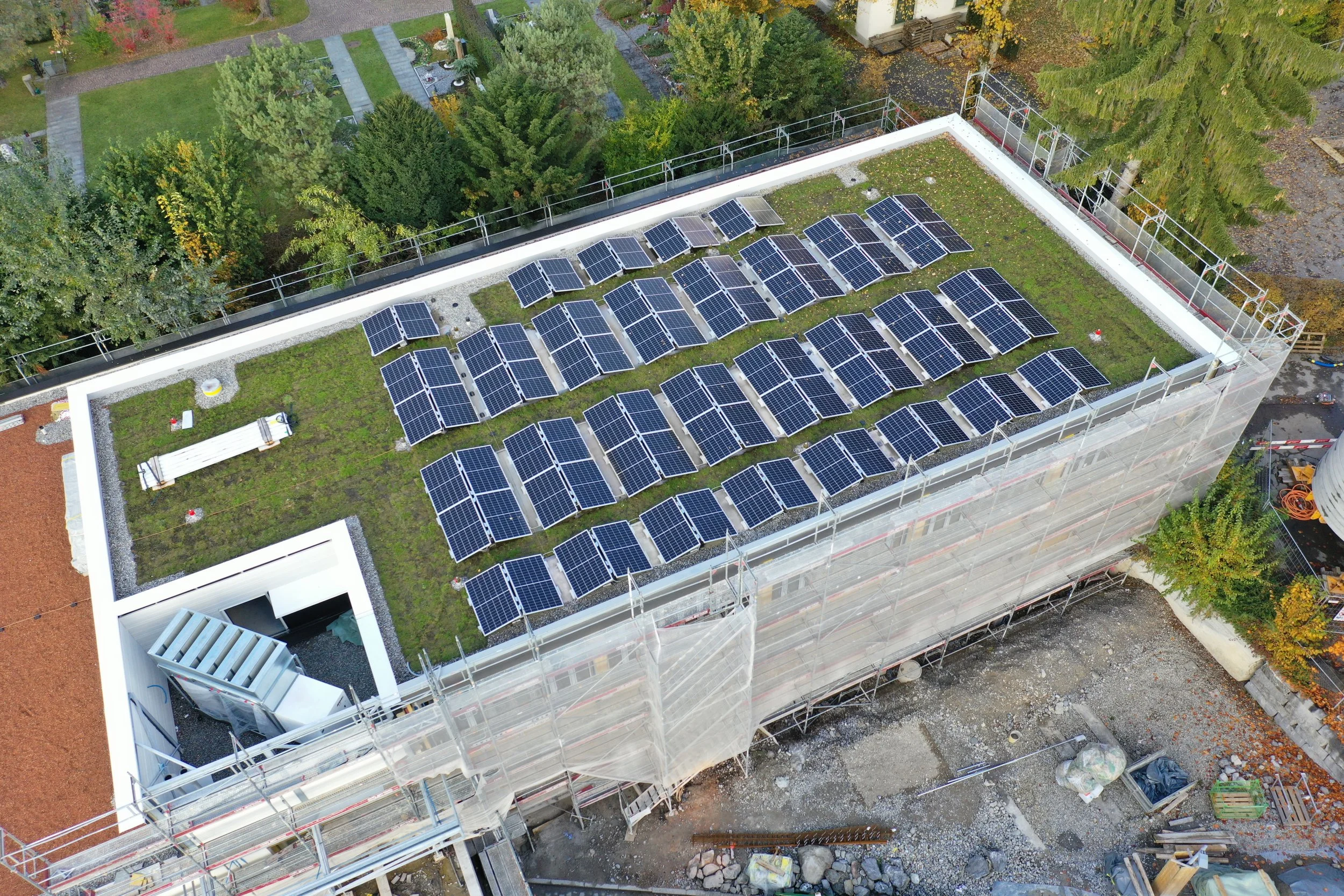The Battle for Surface Area
Advertisement
Green cities with green streets, green squares, green facades and green roofs - the need for greening urban areas has been widely recognized. The advantages of green roofs in terms of cooling effects, microclimate improvement, biodiversity of flora and fauna, and rain retention during heavy rainfall are also well known.
The Sika SolarMount-1 (SSM1) System with an extensive green roof. Photo: Sika
Roofs, especially flat roofs, play a special role in this context. In urban areas, they offer the largest surfaces exposed to sunlight and rain and thus the most easily scalable opportunity to quickly achieve the above-mentioned benefits.
In the course of the energy turnaround (energy crisis), however, these areas have another no less existential function. The surfaces must produce energy - electrical energy - clean energy - sustainable energy – reliably, cost-effectively, directly at the consumer's location - and last but not least, in unimaginably large quantities. Gone are the days when a Photovoltaic (PV) system should only amount to a contribution to household or commercial electricity. The requirements for renewable energy are now generally accepted and are of the following nature: 100%!
What does this mean? We must, as soon as possible, electrify all energy sectors with renewable energy. And these are, besides the well-known household and commercial electricity (energy sector 1), two other and partly much larger energy sectors. The heating sector, which apart from space heating means mainly process heat in industry, and the large area of the mobility sector on land, water and in the air. For many applications, renewable electricity can already be used directly - for other sectors, the conversion of renewable electricity by means of electrolysis to produce hydrogen as an energy carrier is unavoidable.
The main burden (power) of this energy transformation lies mainly on two technologies: wind power and photovoltaics. Both technologies are available, fast to install, clean, reliable, safe and cheap. They complement each other almost perfectly in terms of day and night, summer and winter, centralized and decentralized, rural-urban-water.
Advertisement
Both technologies require one thing above all else to generate energy on a large scale: land! (Surface)
Since wind power is practically impossible to use in urban areas, photovoltaics are of paramount importance here. And thus back to the roof. The roof must make the main contribution to regenerative energy production. The conflict with green areas on the roof is therefore a given.
But why shouldn't both be possible at the same time? Do we have to choose between green and solar PV roofs?
It is possible to do both. With good planning and using the appropriate technology, a roof can be both a green roof with all the known advantages and provide an inexhaustible, clean and cheap source of energy.
Together with its partner Centroplan GmbH from Germany, Sika has developed a solution for this. The basis for this is a photovoltaic mounting system specially designed for flat membrane roofs, the so-called Sika SolarMount-1 (SSM1) system.
Green mats and root free zone. Photo: Sika.
The difference to conventional photovoltaic flat roof mounting systems lies in the way the mounting system is fixed to the roofing membrane. Usually, constructions made of aluminum profiles are placed on the roofing membrane and ballasted by means of stones against the vertical (uplift) forces. The horizontal forces must be safely transferred to the roof structure by means of the static friction between the roofing membrane and the PV mounting system.This is a science in itself - since, in addition to determining the correct coefficient of friction, local wind and rapid loads must be perfectly matched to the geometry of the PV generator in order to prevent the PV system from slipping or lifting off. In practice, this usually only succeeds with large and contiguous PV module arrays. This leaves little to no space for a green area.
The Sika system uses a fundamentally different technique of fixing the PV generator to the roofing membrane. Sika uses precisely fitting molded parts, the so-called Solar Click. This connector to the roofing membrane is made of the same material as the roofing membrane itself (PVC or FPO) and can thus be welded directly to the roofing membrane at the molecular level using hot air.
PV racking system welded directly to the PVC or FPO roofing membrane. Photo: Sika.
The PV system and the roof form a single unit. All horizontal forces are calculated in advance and introduced into the roofing membrane with large safety reserves. All vertical forces (wind suction) are also calculated on a project-specific basis and, if necessary, secured against lifting of the PV generator by means of a generally very small ballast.
Sika’s SSM1 lightweight solar PV system prior to the installation of the green roof. Photo: Sika
The advantages of this fixation technique are the maximum protection of the roof; the lowest additional loads for the roof structure; and in case of green roofs maximum flexibility for the design of the PV generator. The individual systems (from one module to 8 modules) can be installed on the roof completely independently of each other and at any desired distance from each other. This leaves space for the green roof.
In Germany, where the system has been successfully installed for many years, especially on discount stores, the main reason for the development of the SSM1 Green System was the requirement of local authorities to designate the roof areas as green roof areas. The main function of green roofs in urban areas in Germany is stormwater retention during heavy rainfall events to prevent flooding. The authorities' requirement was for a rainfall runoff coefficient of 0.5, which means that the usual amount of rainfall that passes from a flat roof through the drainage system into the city sewer system must only do so at half the normal rate.
Advertisement
SSM1 solar panels in a dense formation, still allow for green roofing and stormwater retention. Photo: Sika.
In cooperation with the Leibniz University in Hanover, various test series were then carried out with the SSM1 system and green mats placed on the roof. With the result that even with a very wide east-west PV system, small distances between the module rows are still sufficient to halve the rain runoff coefficient by means of greening mats.
Thus, with the SSM1 Green System all possible variants of a green photovoltaic roof are conceivable and feasible. From little green to maintain a rain runoff coefficient with maximum energy yield, to a large green area with maximum biodiversity and smaller energy yield. The system is fully adaptable.
Each variant can make sense - if one is aware of the priorities and plans for the use of the roof areas accordingly. If you know the advantages of both types of green roofs and/or photovoltaics, you implicitly know the following design principle: unused roof areas are to be avoided!
Seedum mats providing stormwater retention benefits between rows of solar panels. Photo: Sika.
Nothing makes the principle of leaving no roof area unused clearer than knowing the solar energy yield in a year of a standard PV module of 21sqft (1.95m²) area with about 410 watts of power.
A standard module generates an average annual yield of about 500 kWh in Boston (MA).
In Los Angeles (CA), a standard module generates about 620 kWh per year.
A standard Californian electric car can travel a distance of about 2,500 miles per year with the energy generated from just one standard PV module.
Multiple land (surface) use and roof use, is the art of the future. With these technologies, we can decide how to make unused land and roof space usable for us and our environment in the future and help to address stormwater management challenges and the need to move to 100% renewable energy.
Integrated green roof and solar PV system, very common throughout Germany. Photo: Sika.
Advertisement
Robert Laumen is Senior Project Manager PV systems at Centroplan GmbH and Future Sun GmbH Germany. He’s been in the PV business since 2009.













